UC Berkeley’s four new falcon chicks need names. A contest starts today.
The quadruplets — Annie's 19th, 20th, 21st and 22nd chicks — got a checkup and their ID bands this morning.
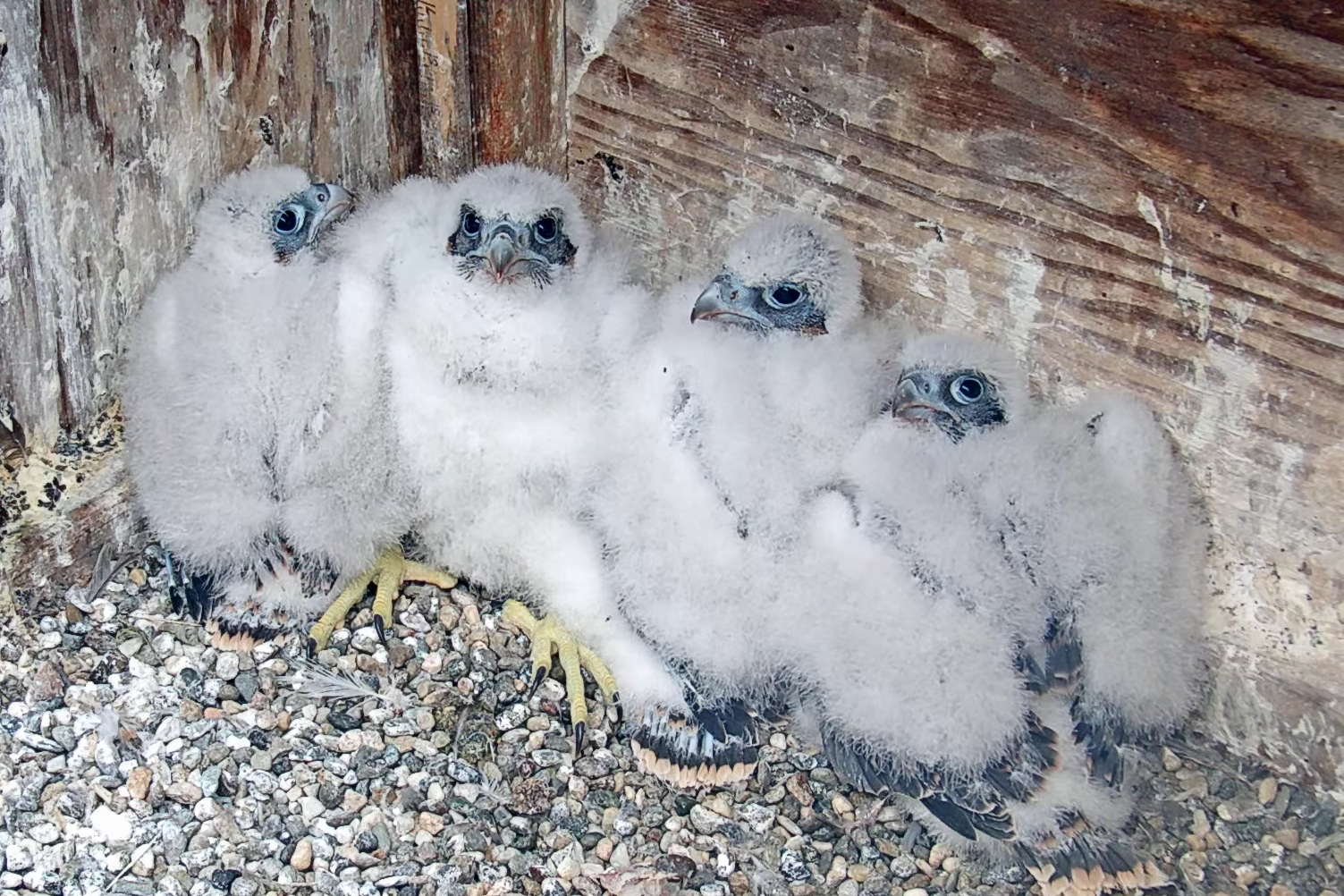
Courtesy of Cal Falcons
May 15, 2024
Their parents, Annie and Archie, weren’t happy, but humans visited the four peregrine falcon chicks on UC Berkeley’s Campanile early this morning to give them a checkup and ID bands. From the width of the nestlings’ legs, the raptor experts determined that two chicks are male, two are female.
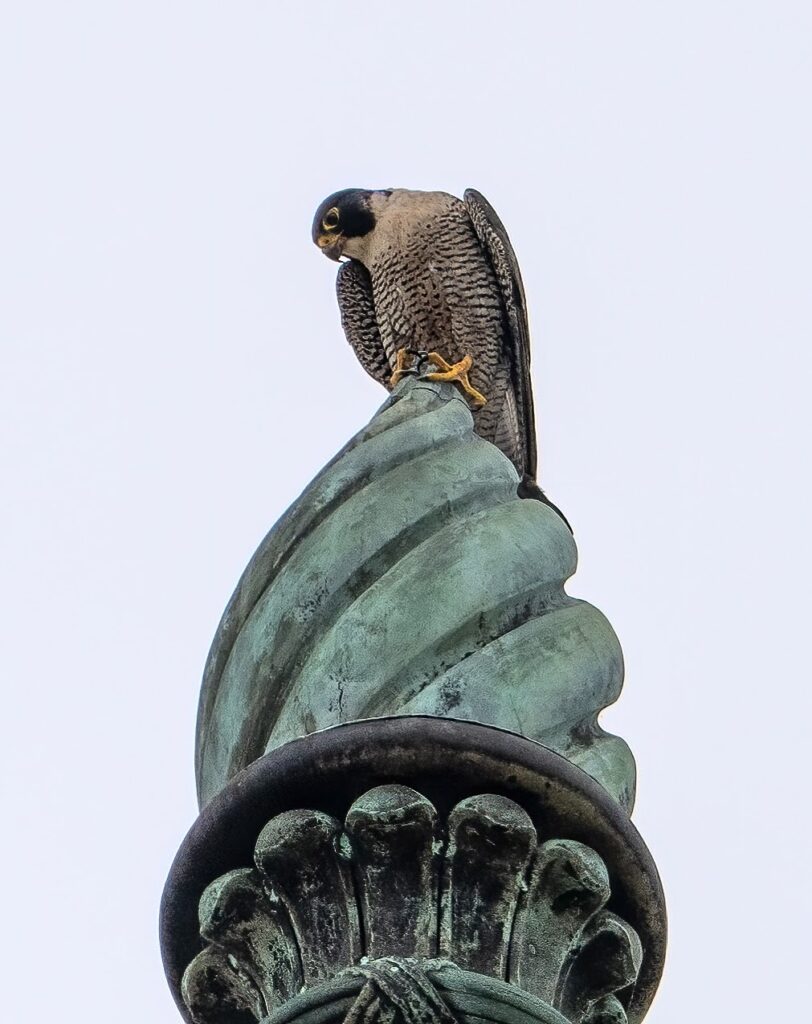
But the individual, nine-digit ID codes on their national Bird Banding Laboratory bands aren’t catchy names, so Cal Falcons launched a contest today asking the general public to propose sets of four names for the chicks. Submissions are due by noon on Sunday, May 19, and instructions can be found on Cal Falcons’ Instagram, Facebook and X sites.
The top suggested sets of names, including a set that can be proposed by youngsters here in a partnership with Berkeley Public Library, will be announced at noon on Monday, May 20, to launch a final vote. The winning names will be revealed Thursday, May 23, at noon.
The names should be connected by theme, but while UC Berkeley-related names are “always a plus,” said Sean Peterson, a Cal Falcons ecologist, they’re not mandatory.
This is the first brood of four chicks for Annie, and her eighth time as a mother since arriving at Berkeley in late 2016. It’s also the first family for Annie and her new mate, Archie.
The chicks have grown quickly since they hatched. Three emerged from their shells on April 22, the fourth on April 24. You can watch their progress 24/7 here.
“Mostly, they look huge!” said Peterson. “It’s really amazing to see how fast they grew in just three weeks. Their flight feathers are just starting to come in, but they’re really going to be working on that over the next two to three weeks.”
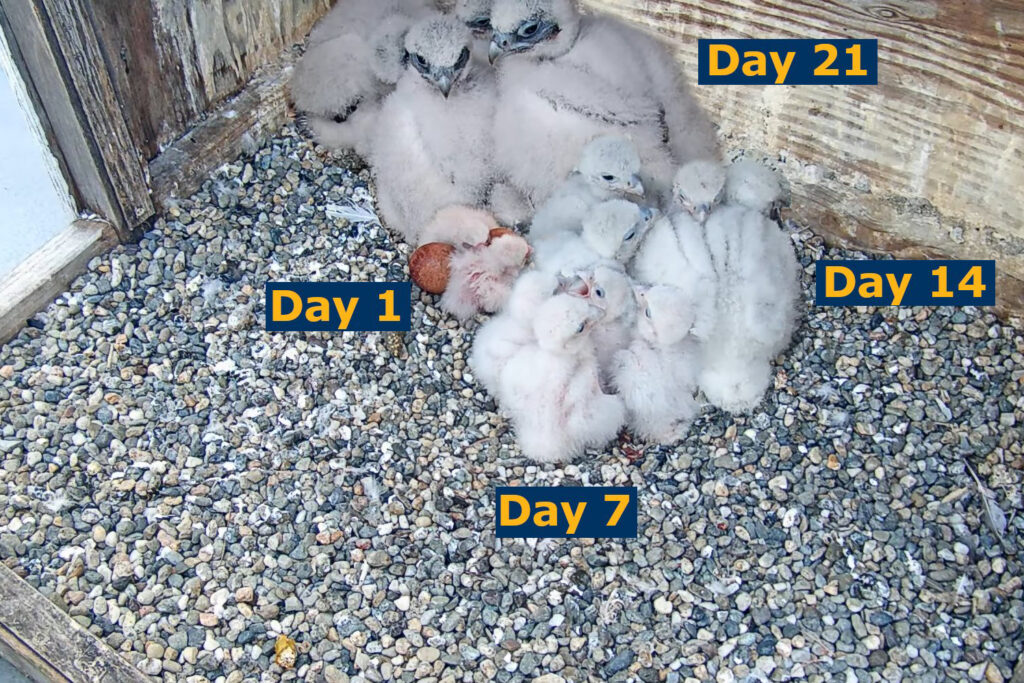
The youngsters’ personalities also are evolving. “One of the chicks, for sure, seems like a bit of an explorer,” he said. “It wanders around the nest a lot and isn’t always found with the others. I’m guessing it will be hard for us to keep up with it on the cameras when it leaves the nest!”
The quadruplets are expected to make their first flights off the bell tower during the first week of June. After that, they’ll spend a month or two practicing their flying skills and learning to hunt before leaving home to find and establish their own territories.
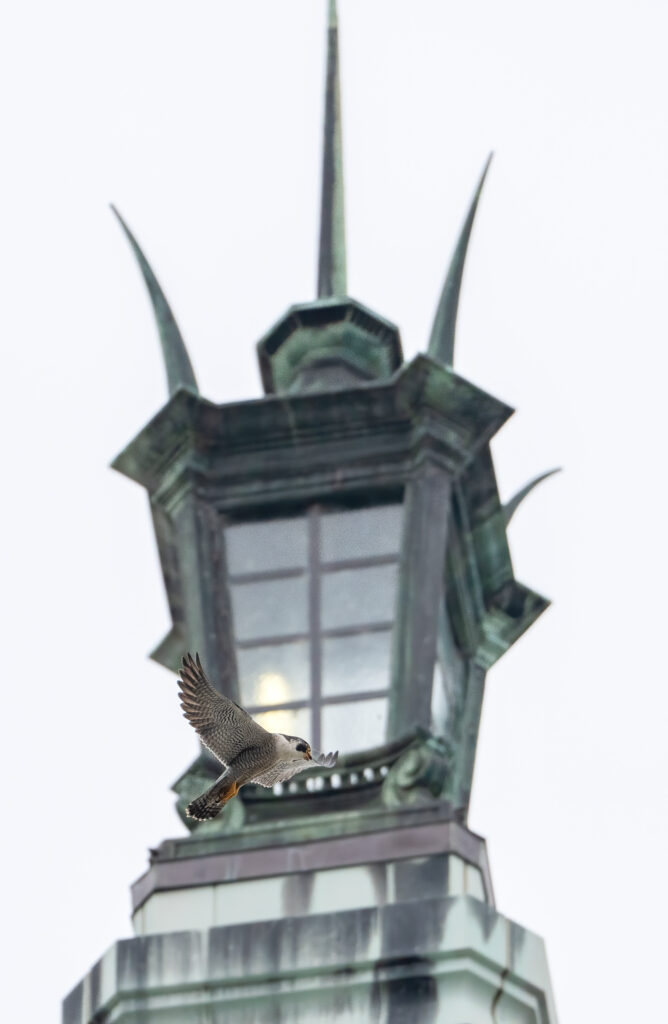
Bridget Ahern for UC Berkeley
Exam results? A squirmy, healthy foursome
Four chicks are a handful, so Zeka Glucs, director of the Santa Cruz Predatory Bird Research Group, and Gavin Emmons, wildlife biologist at Pinnacles National Park, partnered to band the birds.
Both Annie and Archie vocalized loudly nearby, protective of their young and watching them closely. Annie “made a couple dives” at the visitors, said Glucs, who wore a helmet for her own protection, as did Emmons.
Glucs and Emmons determined if the chicks were male or female by measuring the width of their legs, right above their feet. At this point in the birds’ lives, their leg bones are fully developed. Compared to females, male peregrine falcons’ leg bones are thinner at that part of the leg.
Male falcons also are smaller birds than females and take flight first. Females need more time to develop feathers to support a bigger body and generally fly three to five days later than males.
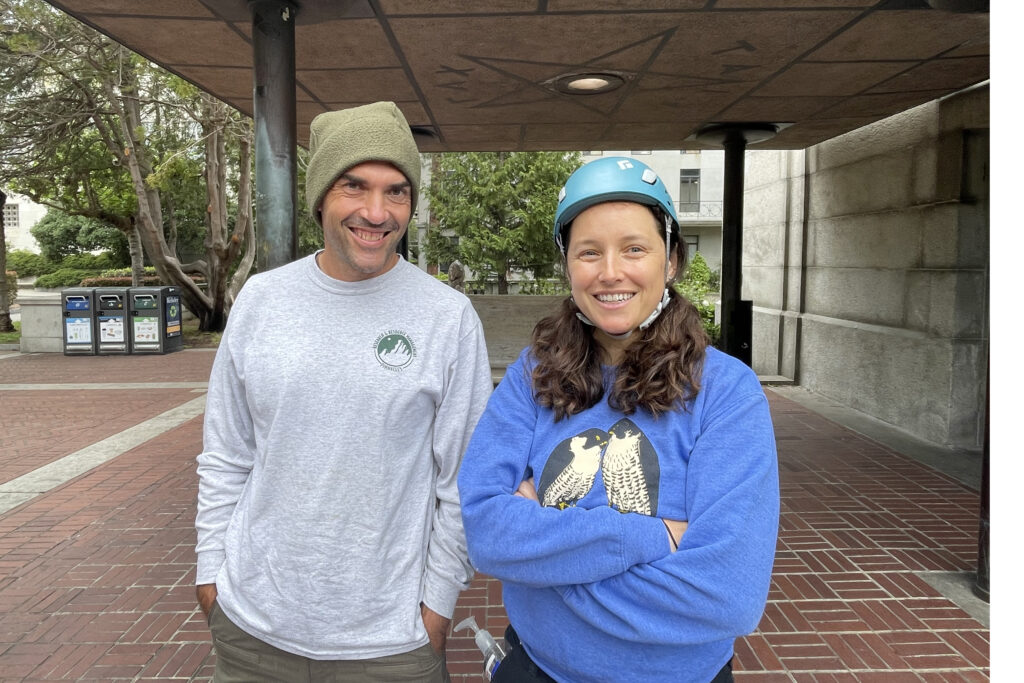
Gretchen Kell/UC Berkeley
“There is no consensus hypothesis on why female raptors tend to be larger than males,” said Peterson. “One theory that I like quite a bit is that it prevents competition for resources between males and females in a pair. The male will generally hunt smaller food, and the female will generally hunt larger, ensuring that they don’t really have to worry about competing with each other.”
Each chick received two ID bands. The first band was issued by the national Bird Banding Laboratory, and the unique numbers on that band differentiate each chick from all other birds banded in North America. These individual numbers are associated with the data collected for a particular bird at the time of banding. The numbers are small and difficult to see if you’re not up close.
The second band has only four characters in much larger type that can be seen through binoculars from afar. This four-character code is enough to differentiate the falcon from other falcons in the region.
Additionally, each of three chicks received a different color of electrical tape around one leg. The colors will help tell them apart, especially when they begin to fly off the tower. Glucs said one female has green tape, her sister has yellow and a brother, blue. The other brother will simply display his silver ID band.

María García-Álvarez/UC Berkeley
It’s just a guess, but Glucs thinks the green tape is on the leg of the oldest of the four chicks. The smallest chick is male and thought to be the last to have hatched.
No red tape was used “to avoid Stanford references, of course,” said Lynn Schofield, a Cal Falcons raptor expert, in a livestreamed Q&A that she and Peterson led at noon about today’s bird banding and to answer questions about Berkeley’s falcons.
Keeping the family safe and fed
Annie has returned to hunting duties, so she and Archie are both busy catching prey for the family’s meals. Annie — known for her ferocity — has even been chasing off intruders, including four osprey earlier this week. Before that, it was a bald eagle, much larger than Annie.
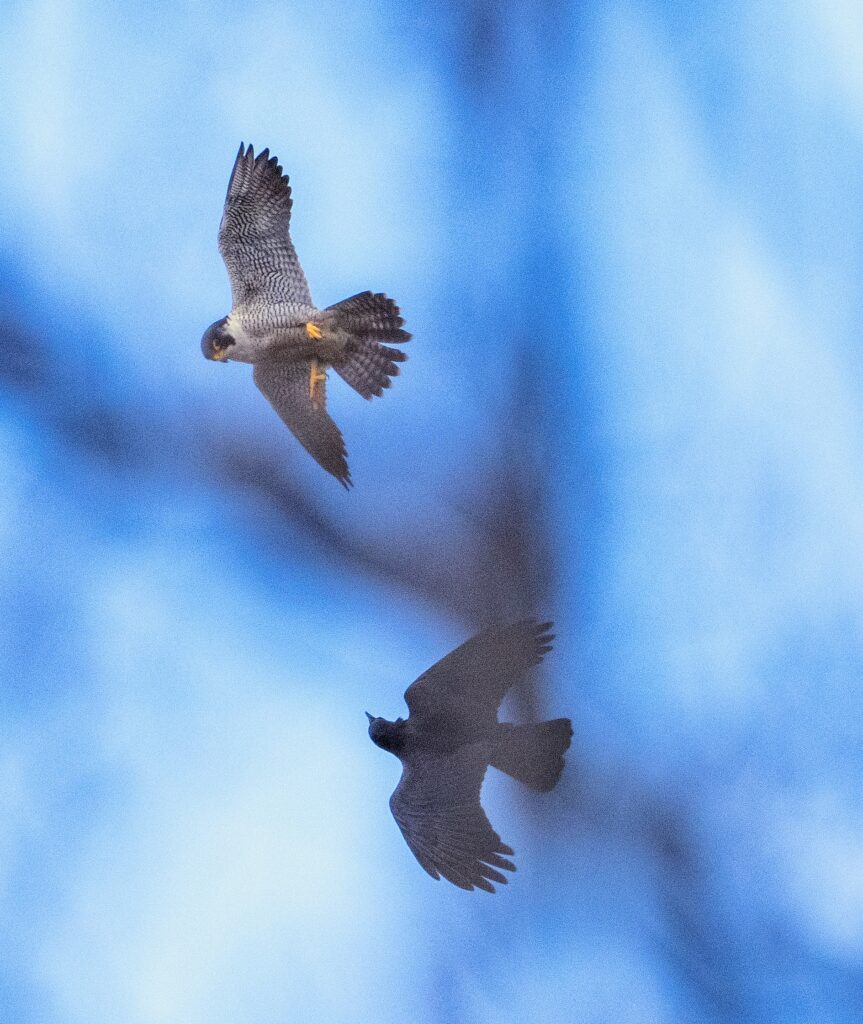
Bridget Ahern for UC Berkeley
“The eagle was almost certainly just traveling from one hunting area to another and was very likely surprised and perhaps a little irritated by a tiny (in comparison) speed-demon chasing it down,” said Peterson. Renowned for their speed, peregrines are aerial hunters that can drop down on their prey at more than 200 miles an hour.
“There are not many birds that are a true threat to a peregrine falcon in the sky,” he said. “They’re just so fast that they don’t really have to worry about other raptors, even those that are much larger than them.”
Until they were about 10 days old, the chicks were fed a limited diet of strictly meat, said Peterson, but now their digestive systems have developed “to the point where they’re able to handle almost anything. So far, we’ve seen them eating feet, bones and all sorts of other gross stuff.”
The same is likely true of the chicks’ new cousins. On Alcatraz Island, Lawrencium, “Larry,” who hatched on the Campanile in 2018 and is the offspring of Annie and her first and longtime mate, Grinnell, is tending to her foursome in a natural cave nest. A live cam shows Larry’s chicks, about two weeks older than Annie’s, nearing their first flights.